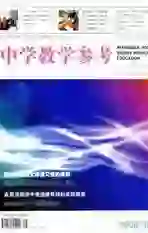巧妙猜词,提高阅读理解能力
2009-12-31王滢
王 滢
我们做英语阅读时,遇到一些生词或者熟词生义的现象在所难免,这就要求我们具有一定的猜词能力,才能提高阅读质量和阅读速度,增强理解能力。下面介绍几种猜词方法。
一、巧用上下文联系猜测词义
阅读时,我们不一定非得弄懂每个词的准确意思,人名、地名等专有名词,往往可以单纯地看作符号,有些只可弄懂大意就可以顺利阅读。根据上下文联系猜测词义的方法在阅读理解中用得很多。例:
1.She carried a basket full of fruits such as apples,grapes,pears,strawberies and so on.
根据上下文不难猜测strawberies也是一种水果。
2. In l861,the Western Union company completed the first transcontinental(洲际的) telegraph line,effectively putting the Pony Express(快马邮递) out of business.
根据前面说的“西方联合公司的第一条洲际电报线路竣工”,说明putting the Pony Express(快马邮递) out of business意为“让快马邮递停止营业”。
二、巧用英文读音判断词义
这类词多为音译过来的,所以阅读时采用这种办法猜测词义很简单,只要弄懂该词读音或者大概的读音就能对下面的阅读大有裨益。例如:
1.The marathon might not be everyones cup of teaso read on and learn about different ways you can get fit in London.
2.The Chinese Kongfu has a long history.
按照读音,两句中的画线部分意思各为“马拉松赛跑”和“中国功夫”。
三、巧用构词法猜词
英语构词法主要有三种:转化词、合成词和派生词。转化词的词形不变,词性、词义发生改变,但词义仍然和原来的词有关。合成词由两个或两个以上的单词构成另一个新词,该新词的词义往往是构成它本身各部分词义的组合体。派生词是通过加前缀或后缀,从而改变词的类别或构成否定含义等等。例如:
1.Judging from what he said,I found him dishonest.
honest意为“诚实的”,而加前缀dis?鄄构成否定含义,所以可猜译dishonest就是“不诚实的”。
2.Reporters often take photographers with them who also act as primary sources by giving us pictures of events.
photograph意为“拍照”或“照片”,动词后加?鄄er常指发出某个动作的主体,所以可猜测photographer就是“拍照片的人”,即“摄影师”。
四、利用同义、反义或对比关系猜测词义
英语中有大量的同义词,他们多在用法上和意义上都有差别,用法和意义完全相同的同义词是极少的,但它们的含义大致是相同的,可根据熟悉的词语来推知与之有着同义关系的陌生词语的含义。例:
Doctors believe that smoking cigarettes is detrimental to your health.They also regard drinking as harmful.
显然,句中detrimental的同义词是harmful,据此我们可以推测detrimental的意思是“有害的”,能够呈现反义的词有but,while,however等。试看例子:
It is strange that this part of the sea is salty while an?鄄other part is fresh. while在本句中表示转折对比关系,意为“而”。由此可猜与salty相对的fresh应当译成“淡的”。
五、巧用定义或解释猜测词义
给某个词解释或下定义,常用上is,that is,that is to say,mean,in other words,或运用非限制性定语从句、同位语加于解释。
1.This denim drive is a call?鄄to?鄄action to donate denim and give it“new life” by changing it into Ultra Touch TM Natural Cotton Fiber Insulation, which is used to help build houses in places that have been damaged by hurri?鄄canes and other disaters.
根据which引导的非限制性定语从句是对Ultra Touch TM Natural Cotton Fiber Insulation含义的补充说明,显然denim指的是一种建筑材料。
2.Oxygen is a gas without colour,taste,or smell,pre?鄄sent in the air, and necessary to the existence of all forms of life.
据解释,oxygen是一种“无色、无味、散布于空气中、生命赖于生存”的气体,应该为“氧气”。
六、巧用经验或常识猜词
我们在日常生活工作中都积累了一定的经验,掌握了一定的常识,因此在阅读时,可先借助经验或常识判断所描述的是什么或怎么样进而猜测词义。例:
1.Before we moved in the new house,we bought many pieces of furniture.
根据常识,搬新家之前,人们往往购置许多新家具,因此furniture无疑就是“家具”了。
2.Dad got on his motorbike,and Mom sat behind him on the pillion.据“爸爸骑上摩托车,妈妈坐在他身后”可知pillion是“后座”。
七、根据描绘想象或比喻猜词
这要求我们在积累一定经验、掌握一定常识的基础上对所描写的事物进行猜测,或者必须先找出本体和喻体之间的关系,进而猜词。
1.The natives made popcorns in this way:firstly, then placed the corn seeds on the pans on the open fire. Then they waited and suddenly the seeds began to hot about and to burst with a loud noise:Pop!Pop!Pop!文中对制作popcorns的描写:把玉米放在已经加热的平底锅上,稍后,突然玉米发出“叭!”“叭”!“叭!”的爆破声,同时四处跳开。说明所描述的popcorns是“爆米花”。
2.Catherline is the only girl in the family,so she is an appple of her parentss eyes.
Catherline被比喻成“父母眼中的苹果”。根据“她是家中唯一的女孩”,an appple of her parentss eyes就是“父母的掌上明珠”。
实际上,有相当一部分的词语可以通过多种方法来猜译,但是如果孤立地从一个词、一句话去理解,有时会误解其意。比如:greenhouse,如果只凭构词法来猜测,则可能被译成“绿色房子”。因此,正确的做法是:从理解文章的整体意思出发,结合上下文,尽可能推测得合理些。值得注意的是,词汇量大是成功推测词义的基础,而大量的词汇来自大量地阅读。掌握了方法和技巧,增加阅读量,定能更快地提高英语的阅读效率。
(责编 黄 晓)
